The moral righteousness of the Western genre with its clear definitions of good vs. evil looks quaint from where we find ourselves in 2014. If heroes are symbols of evolving cultural values, the fact that our pantheon is a line up of likeable “terrorists,” criminals and sleeper agents indicates a national identity in crisis. In this Brave New World where bad is the new good, con artists restore faith in the American dream while PTSD-wracked detectives are today’s guardians of order.
Out of the contradictions and uncertainties of the American situation, the “Southern” has emerged as the “Western” of our time. Ambient and immersive treatments of the historically and geographically baroque south provide a metaphorical space for audiences to contemplate the twin ghost-worlds of our preindustrial past and post-industrial present.
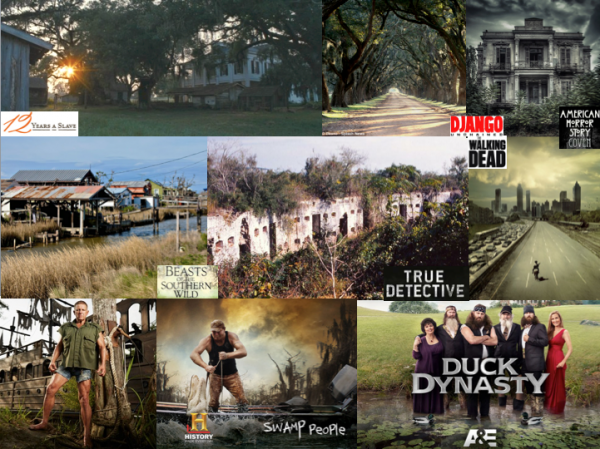
The rise of The Southern: film and television representations of Louisiana or the Deep South
Republic vs. Empire
True Detective engages the symbolism of the Deep South by leveraging the neglected infrastructure and environmental collapse of contemporary Louisiana for its aesthetic language, tonality and plot. From title design onward, the landscape and the ubiquitous oil refineries have dramatic significance on a par with the show’s protagonists as a nonverbal means by which contesting visions of American-ness are played out against each other.
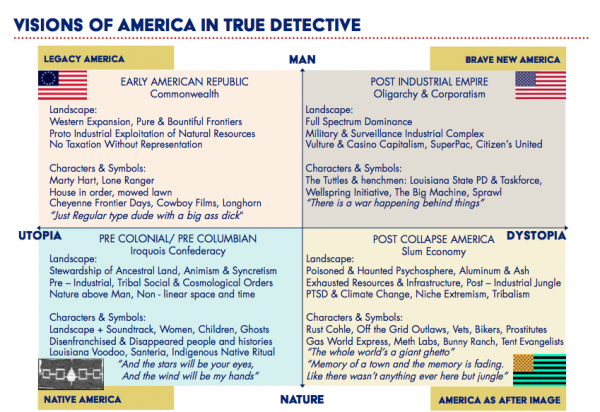
Contesting visions of America in True Detective
Immersive and dramatic aerial shots of the Louisiana bayou are a counterpoint to the heady, philosophical dialectic between Marty and Rust. The borderline between the suburbs and the swamp highlights how fine the line is between civilization and wilderness, directing our attention toward the point at which domesticity ends and ferality begins.
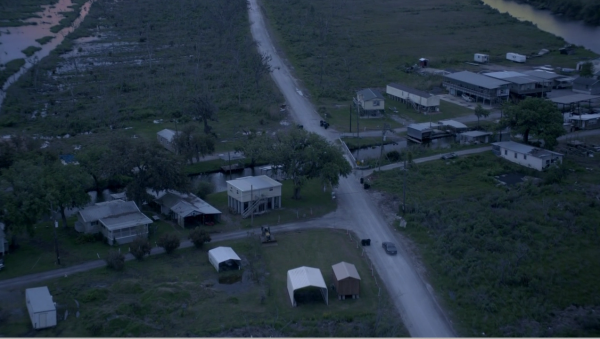
The fine line between wilderness and civilization
Marty Hart is surrounded by the symbols of Legacy America. As a caricature of the “Lone Ranger,” he embodies the values of the Early American Republic with his salt of the earth faith in boundaries, community, and “decency.” In Marty’s worldview, everything has its place. As a self-described “regular guy with a big ass dick,” he even frames marital infidelity as having a role in maintaining the order of his family life. When he gets home from work, he puts his keys in the same spot. He’s territorial–he “likes mowing his own lawn.”
Marty is a “people person,” a domesticated frontiersman & guardian of social order, even after his personal world collapses. When he leaves the Louisiana State PD to start his own small business, “Hart Investigative Solutions,” the singular decorative addition to the office is a “Cheyenne Frontier Days” poster. In the years after his divorce, he eats TV dinners while watching Cowboy movies. When he reunites with Rust to repay their “debt” and focus on solving the case together, he speaks on behalf of Legacy America when he confides, “you end up becomin’ somethin’ you never intended. I guess you never even really know why.”
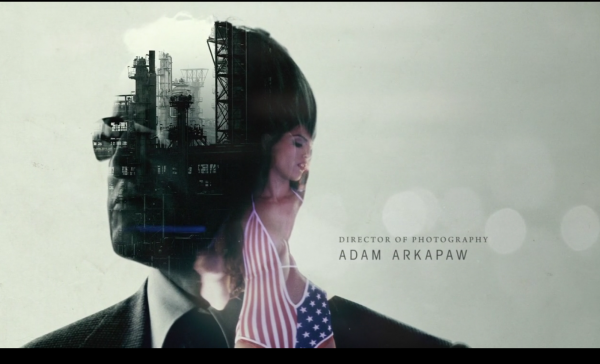
“Illegal business controls America” – Boogie Down Productions (Strip club / oil refinery title
montage)
America as Afterimage
“This place is like somebody’s memory of a town and the memory is fading. Looks like there wasn’t anything here but jungle”
Wilderness is a constant threat to order in True Detective. Neglected weeds grow between the cracks, along deserted freeways and in the broken pavement of abandoned parking lots. Orphaned bikes rust away in indeterminate piles of litter as the whole rottenpost-hurricane mess melts into a lush overgrowth that swallows up traces of a civilization that once was. As if to flaunt the victory of chaos over order, the weeds show America as a forgotten afterimage of itself and reveals it for the “jungle” it has become and was before.
Rust Cohle is the nocturnal opposite of Marty, a symbol of the deterioration and chaos of post-collapse America. In Rust’s worldview, the American Dream was only ever a ghost. Marty describes Cohle‘s “rawboned” ferality by telling the detectives it “took three months to get him over to the house for dinner.” Off the grid and without a television or a family, Rust doesn’t recognize institutional order (“Who the fuck’s Eddy?”) or the myth of progress (“Time is a flat circle”). His home is Spartan, bereft of the domestic trappings of the American dream and its accompanying melodramatic distractions. Abandoned by his mother, raised by a Vietnam vet, and having lost the daughter and wife he had, Cohle’s life as “a cycle of violence and degradation” endows him with a “real mind” for the case.
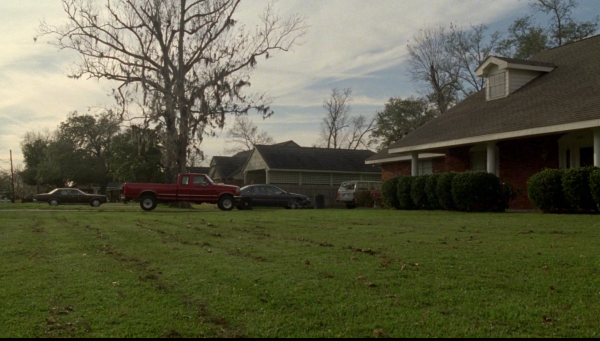
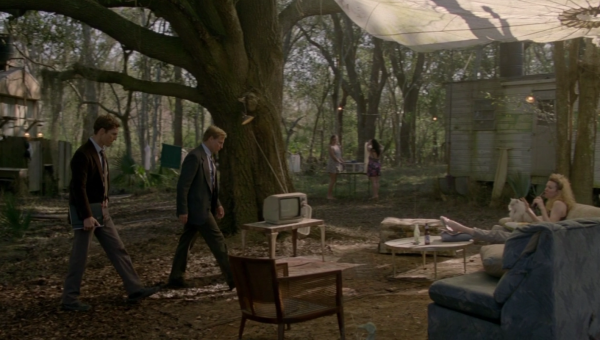
Pre and post collapse visions of America – top: Marty’s Legacy America. “I like mowing my own lawn” “ vs. bottom: “This your place?” / “Its my lease.” A feral living room at the Bunny ranch presents the slum economy waiting at the end of the American Dream.
Dystopian, Post-Collapse America is marked by a new kind of tribalism and “niche extremism” that requires both pre-industrial survival skills like bow hunting, as well as modern military training. Rust’s hypersensitivity endows him with the ability to see beyond things, to “mainline the secret truth of the universe.” His relationship to the “psychosphere” connects him with the cosmological mappings of a pre-colonial landscape.
Rust begins the six-minute tracking shot of the stash house heist by feeling his pulse. The south Texas ghetto scene unfolds in the single shooter gaming aesthetics of Call of Duty, implicitly reframing conventions of the Western shootout with cinematic vocabulary of 21st century warfare. As rogue cop disguised as outlaw disguised as cop, Rust taps into a natural order overriding a parade of illusions. His language devolves into a primal growl as he rides the rising violence in a flow state.
It is only through the hallucinogenic lens of PTSD and synesthesia that Rust can clearly read through the cognitive dissonance of corporate brandspeak (The “Wellspring Initiative”) and see it for what it really is in order to track corruption’s “sprawl.” By using instinct to “read the signs” across the “aluminum and ash” bayou where “nothing grows in the right direction”, Rust maintains a “meta” relationship with social order to subvert and survive it. From his place outside and between, he is uniquely suited to decode the doublespeak of institutional power (The Tuttles, Louisiana State Police Department and the taskforce) and negotiate the terrain of outlaw life (Iron Crusaders, Gas World Express, and drug cartels).
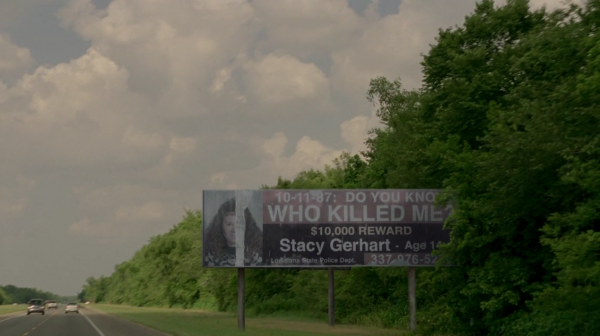
Pipelines covering up this coast like a jigsaw. Place is gonna be under water in 30 years.
Precolonial America–-Do You Believe In Ghosts?
Children signify the future as they convey generational, long-view thinking. The disappearance of women and children in True Detective is tantamount to an end for humanity. The surviving family members of victims are speechless and broken. Trauma, grief and addiction has stopped time for them. They wear their trauma and live half-lives, paralyzed by “cerebral events” and crippled by migraines from mysterious chemicals.
Immersive aerial views of sugar cane fields, cypress groves, and lush jungle are presented from above or in tracking shots and transitions that draw visceral connections between the physical degradation and disappearance of the bayou communities and the ubiquitous presence of oil refineries. In Episode 2 we cut from Ms. Kelly bending over in pain from “headaches that come on like storms” and close ups of her chemically damaged nails to an aerial view of the bayou. The tattered bayou, like the violated bodies of ritual murder victims is “cut up like a jigsaw” by oil pipelines and refineries, doomed to disappear like the voiceless “unsolveds” whose records are “filed in error” and don’t get press.
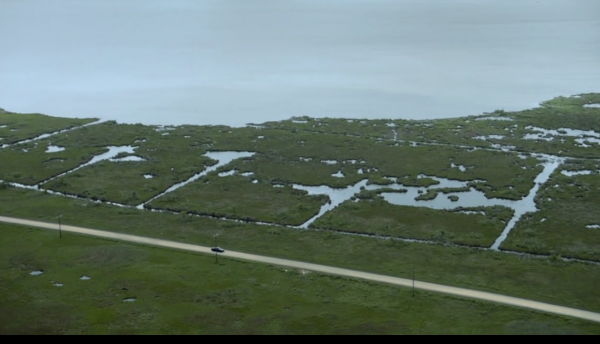
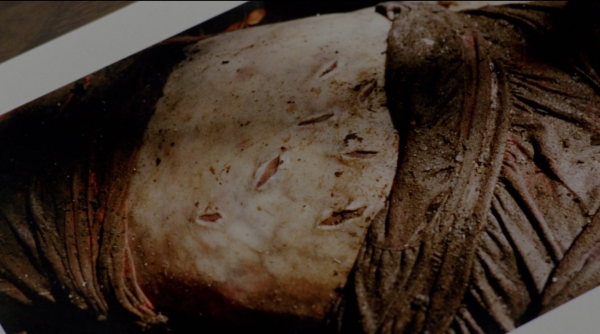
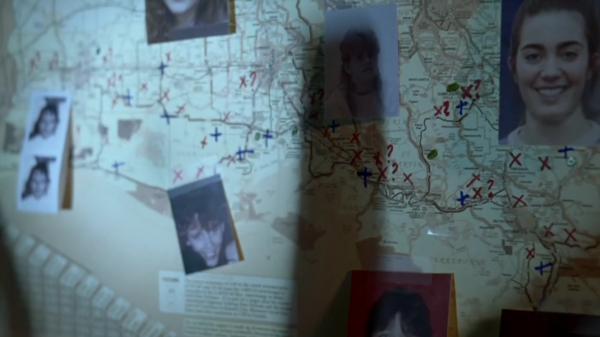
The landscape as symbol of the disappeared and disenfranchised
As a silent witness to atrocity, the landscape becomes the voice of the disappeared, which Rust is able to decipher by listening to other sensorial input ignored by Enlightment prejudice toward visible, observed, reality. By hearing color and tasting sound, he takes guidance from cosmological and metaphysical orders to read the signs of the exhausted, poisoned landscape. The landscape reminds us through its accompanying soundtrack of judgment and redemption, what is “owed by our society for our mutual illusions.”
Louisiana’s not land/not water landscape becomes a shattered mirror to project our disappearing future onto. The landscape speaks sensorially, through a soundtrack of slave songs, indigenous symbols, talisman and rituals–traces of cultures and practices disappeared by genocidal economies of Antebellum South and the Western Expansion. When Rust notices a billboard for missing children that reads “Who Killed Me?” the voice of our future and our past speaks simultaneously.
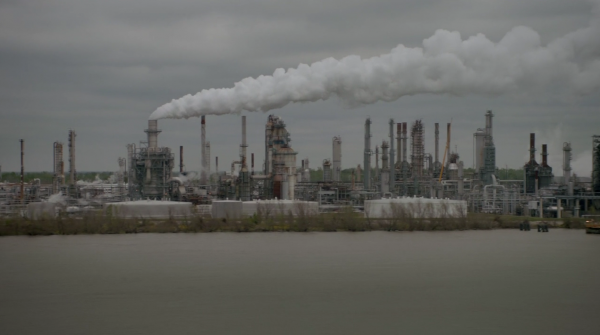
According to Marty, “The Detective’s Curse” is the inability of a detective to read signs right
under his nose because he’s following the wrong clues.
The Detective’s Curse
“It was a horrible, horrible thing. We saw it on TV – what we’re in the clutches of and I prayed and prayed for that [woman’s] family- and its me, its me.”
“Sprawl” is a symbol of the omnipresence of corporate influence in today’s Brave New America. The full spectrum dominance of the Tuttle family tree–their involvement in “a lot of different things” reaching from the police department to the news media–is an oblique reference to the Prism-riddled, crony capitalism of Empire. “How about we track all the missing persons within ten miles of every Walmart? In fact, why don’t we go after Sam Walmart?,” the police chief facetiously asks before dismissing Rust for insubordination.
This sprawling “family tree” is marked on the one hand by the ubiquitous presence of menacing oil refineries, and on the other by the conspicuous absence of evidence for the dead and missing women and children disappearing across bayou country. Metaphors of veils, illusions, and blindness, are woven throughout the series. “We’re in a muddy swamp here and the alligators are swimming all around us…we don’t see em”–says Rust. The hubris of consumerism and its looming debt has made “everybody think they gonna be somebody that they not” and “like a lot of dreams, there’s a monster at the end of it.”
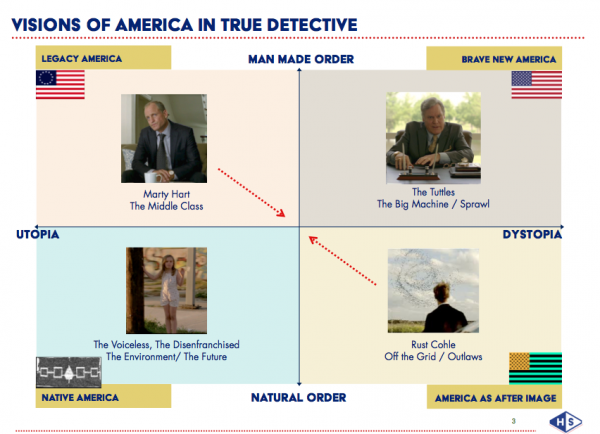
How light won over darkness
“Without me there is no you”
Marty works within the system and then steps out of it, closer toward Rust. Rust, in his older age opens up toward Marty. The intimacy and power of their union toward a single–minded cause not only makes good storytelling, but is good political strategy. As symbols of contrasting worldviews, it is politically significant that Marty and Rust breach their ideological divide to overcome darkness together.
In the real war going on “underneath things” in which values of the Republic are threatened by the private interest of Empire, light just might have a shot against darkness if we are able to trust intuition over appearance and accept both the power and the limits of individualism. But that would take watching our national tragedy unfold on TV as if we had something real at stake.
Marian St. Laurent, founder of Heavy Symbols, LLC is a media consultant and
cultural analyst
Essays
A brilliant analysis, I enjoyed this immensely.
I couldn’t explain to friends exactly how all the elements in True Detective came together to make this show such a powerful and prophetic work of art. thanks to this article, I don’t have to–it’s all right here. what I sensed but couldn’t find the words for. Thank you Marain St. Laurent.
This was excellent, thanks for posting. Makes me want to watch it all again.
So much bullshit you’ve just written. Pos-colonialist indoctrinating Crap. “Genocidal economies” hhahahaha because i’m sure it was paradise before europeans and capitalism hahahaha “poor indians”.
A haunting meditation on American decay—*True Detective* reframes the Western myth through the Southern Gothic lens, revealing a poisoned dreamscape where trauma, corruption, and forgotten souls shape a new kind of heroism. gaming